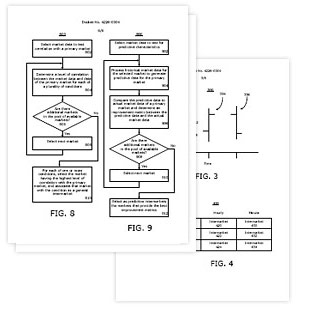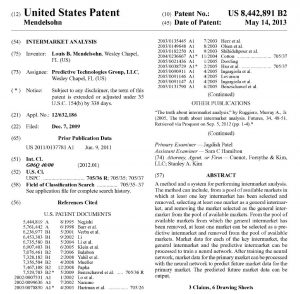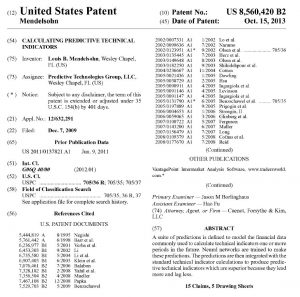The #1 Question A.I. Traders Should Ask – “Is it Patented?”
“Going through a patent process is very rigorous… You have to actually have something that’s unique. You have to actually have something that adds value.” Don’t be fooled by imitators. Vantagepoint A.I. President, Lane Mendelsohn, lays out why vetting A.I. software for patented technology is crucial for traders, and delves into VantagePoint’s 2 U.S. patents in this interview clip at the New York Stock Exchange.
Scroll below to learn more about our U.S. patents.

Intermarket Analysis
Patent No. US 8,442,891 B2 Date of Patent: May 14th, 2013
This invention relates to methods and systems for performing intermarket analysis using neural networks. The invention details proprietary methods and processes for selecting from a large pool of available global financial markets the related markets that have the highest relevance in training neural networks to make market forecasts for each ‘primary’ market with a high degree of predictive accuracy. This selection process includes determining ‘key’ intermarkets, ‘general’ intermarkets, and ‘predictive’ intermarkets from the pool of available markets that correspond to each ‘primary’ market.
Market data for each of the key intermarkets, the general intermarkets and the predictive intermarkets can then be processed to train neural networks so that when the neural networks process this input data, predictive output data generated by the neural networks for each primary market are as accurate as possible. After training the neural networks, all relevant market data for each primary market can be processed with the neural networks to predict future market data for each primary market with the predicted future market data then used to arrive at a predictive technical indicator for use by the trader in making trading decisions.
Calculating Predictive Technical Indicators
Patent No. US 8,560,420 Date of Patent: October 15, 2013
This invention relates to methods and systems for calculating predictive technical analysis indicators. The premise behind technical analysis is that all the factors that affect a specific market at any given point in time are already built into that market’s price. Technically oriented traders have come up with a variety of computerized calculations that concentrate on using various technical studies and indicators to analyze market behavior.

Some of the more common technical indicators include trend indicators, momentum indicators, and volatility indicators. Many technical indicators, such as moving averages, attempt to filter out short-term variation in price so the underlying trend can be observed. A side effect of doing this is that the technical indicator tends to lag behind the market. Such technical indicators are referred to as trend following or lagging indicators. This lag effect causes the trader to respond late to market changes, resulting in lost profit opportunity and risk of increased losses.
This invention overcomes this lag effect through the development of methods, systems, and devices for calculating predictive (leading) technical indicators that do not lag behind the market, based on the combination of both historical and predicted data derived from the application of neural networks to intermarket data related to each specific primary market.
In one aspect of the invention, an algorithm is used to integrate the predicted data with conventional technical indicator information to arrive at a predictive technical indicator that can lead market behavior, thereby overcoming the limitations related to the lag effect that was previously thought to be an inherent aspect of the technical indicator.
In the early years most of Mr. Mendelsohn’s research was done by trial and error as well as computer brute force and was very labor intensive. Recently, after a major financial investment in state-of-the-art computer servers and development of its highly sophisticated, proprietary in-house research software training platform, the Predictive Technologies Group has automated most of the mathematical processes related to performing the necessary steps to execute intermarket analysis and produce predictive technical indicators that make extremely accurate short term market forecasts possible. This automation has been accomplished using the servers as intelligent robots.
In the future very little human intervention or judgmental decisions will be necessary to train and select the final application neural networks to be used in future trading software programs developed by Mr. Mendelsohn and his team of researchers. This complex research methodology developed and perfected over the past 30 years since Mr. Mendelsohn first began applying neural network pattern recognition to global intermarket data at a cost of millions of dollars in R&D, is the subject matter of two highly technical patent applications Mr. Mendelsohn filed on December 7, 2009 with the U.S. Patent Office, in which he has revealed for the first time how his research technology works.






